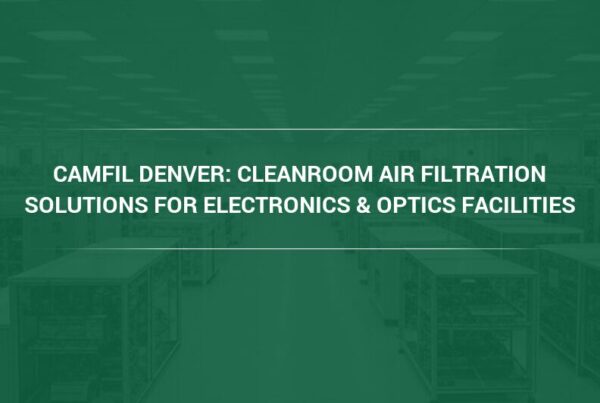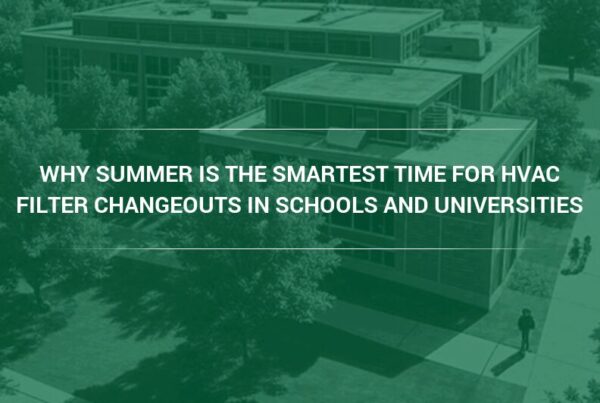By now it’s a known fact that air pollution can cause a plethora of health problems, especially for at-risk segments of the population such as the elderly, pregnant women, and children. In turn, this has driven the demand for commercial air filtration systems, which can now be found in schools, healthcare facilities, retail stores, manufacturing facilities, and airports among many others.
Link Between Weight Gain In Children and Bad Air Quality
“The dangers of air pollution and poor indoor air quality are particularly serious for children,” says Camfil USA’s Charlie Seyffer, Manager of Marketing & Technical Materials for commercial air filters and 37-year ASHRAE member and active committee participant.
In fact, a 2015 study published in the New England Journal of Medicine found that children who came of age in the 2000s in Southern California, a region notorious for having the worst air pollution in the entire country, have superior lung function compared to children who came of age in the previous decade.
Researchers from the University of Southern California (USC) Children’s Health Study surveyed the lung health of children ages 11 to 15 and found that those evaluated from 2007 and 2011 displayed better lung function compared to children surveyed between 1994 and 1998, and 1997 and 2001.
The reason? Although California continues to struggle with air quality—due mainly to the massive number of cars in the region—they’ve made great strides in lowering air pollution levels over the years.
While several studies already point to the links between air pollution and respiratory diseases like asthma and chronic bronchitis, other studies have also shown that air pollution is linked to other health issues you wouldn’t expect associated with air quality issues.
High Efficiency Air Filters for Childhood Obesity
If the need for high efficiency air filters wasn’t obvious enough, a recent study published in the American Journal of Respiratory and Critical Care Medicine found that children with asthma were at least 51 percent more likely to become obese over the next 10 years, compared to children who did not develop asthma symptoms.
According to Frank Gilliland, the study’s senior author and a professor of preventive medicine at the University of Southern California’s Keck School of Medicine, the problem may be caused by a vicious cycle where asthma and obesity feed off each other.
The team of USC researchers looked at the records of more than 2,100 kindergarteners and first-graders in Southern California over a period of 10 years. At the time when the study began, 13.5 percent of the children were asthmatic. Over the next decade, 15.8 percent became obese.
While many studies show that many children with asthma tend to be overweight or obese, the scientific literature hasn’t been able to confirm that asthma causes obesity. The researchers, however, suggested a few possible reasons connecting childhood obesity and asthma.
- Respiratory problems may cause asthmatic children to play and exercise less.
- Weight gain is a known side effect of many asthma medications.
But that’s not all. The combination of elevated asthma symptoms and childhood obesity can contribute to the development of even more metabolic disease, including prediabetes in children and Type 2 diabetes upon reaching adulthood.
But why and how does air pollution cause asthma in the first place?
Biological Pollutants and the Link with Indoor Air Quality
Biological contaminants comprise a wide assortment of dead and living organisms, which, when inhaled, may cause a host of health issues associated with poor indoor air quality, such as allergy attacks, asthma, other respiratory problems, and inflammation among other issues.
When the particulate matter in contaminated air enters the alveoli in the lungs, they trigger an allergic reaction that may cause the airways to constrict, tightness of chest, and shortness of breath—the classic symptoms of asthma.
According to statistics from the American College of Allergy, Asthma and Immunology (ACAAI), more than 28 million children suffer from allergies. Of that number, 7.1 million suffer from asthma. Not surprisingly, allergy symptoms are also the second most common reason for sick days among adults.
Although biological contaminants can come from external sources such as plants, which carry pollen, as well as people and animals, which can carry viruses and bacteria, they also occur naturally in indoor spaces. Practically any area with nutrients and moisture will create the perfect environment for biological contaminants; think bathrooms, wet appliances such as humidifiers and air conditioning units, flooded basements, or damp carpeting.
Aside from being health hazards, these disease-causing contaminants can do serious damage to surfaces inside and outside of buildings, including schools and universities. Mold and mildew, for example, can damage your plumbing, walls, ceilings, and flooring.
How Commercial Air Filtration Systems Remove Disease-Causing Pollutants
Commercial air filtration systems come at a time of growing awareness of the health hazards of polluted air, a development made possible by the passage of the Clean Air Act and regulations by the United States Environmental Protection Agency (EPA).
The EPA, in turn, determines the National Ambient Air Quality Standard (NAAQS) for PM2.5, or particulate under 2.5 microns in size.
- The NAAQs for year-round levels of PM2.5 is set at 12 micrograms per cubic meter (μg/m3)
- For 24-hour levels of PM2.5, the standard is set at 65 μg/m3
The EPA also recommends the installation of commercial air filters to contain the presence of biological contaminants in the air, such as:
- Bacteria
- Viruses
- Animal dander
- House dust
- Dust mites
- Cockroach droppings
- Rat and mice urine
These contaminants are also known triggers of asthma symptoms.
“The problem with biological contaminants in indoor spaces is that they come from a long list of sources, many of which are right inside the rooms we spend most of our time in,” adds Seyffer. “Even with an air filtration system, it’s important to do something about the source of these pollutants.”
Maximizing the Effectiveness of Commercial High Efficiency Filters
Aside from installing commercial high efficiency air filters, school administrators and building owners face the challenge of creating an environment that limits, if not prevents, the presence and growth of biological contaminants. To combat airborne biological contaminants, the EPA suggests measures such as:
-
- Maintaining low indoor humidity levels, ideally below 50 percent, to remove moisture from the air
- Removing all traces of standing water
- Drying wet surfaces
- Removing materials permanently damaged by water
Remember, damp or moist materials are the perfect breeding ground for disease-causing mold, mildew, bacteria, and insects. It’s also where dust mites like to grow and multiply.
Fortunately, the solution to damp environments is to introduce a steady stream of dry, outside air. Ventilation, however, presents another problem: polluted air from the outside. This process is where a commercial high efficiency air filter becomes crucial in stabilizing a room’s indoor air quality.
When attached to a heating, ventilation, and air conditioning (HVAC) unit, a high efficiency air filter captures and removes pollutants from the air as they enter the HVAC system and ductwork, ensuring that any air circulating inside a room or brought in from the outside is free of contaminants.
Supporting Health and Wellness with Commercial Air Purification Systems
Remember, commercial air purification systems work best when paired with proper ventilation and taking action against the source of disease-causing contaminants. They address the symptoms of polluted indoor air, but not its source, so be sure to take a holistic approach when improving air quality in your school and buildings. If you are interested in learning more about protecting children while they are in school, visit Camfil’s research on air filtration for schools.
For more information on improving your indoor air quality with commercial air filtration systems, get in touch with the Camfil USA air filtration experts or find a Camfil USA location near you.
Lynne Laake
Camfil USA Air Filters
T: 888.599.6620
E: Lynne.Laake@camfil.com
Y: Watch Camfil Videos on YouTube
T: Follow Camfil USA on Twitter
F: Friend Camfil USA on Facebook



